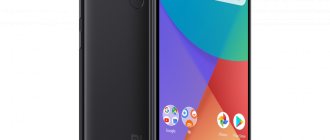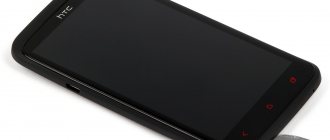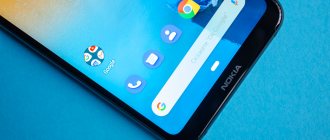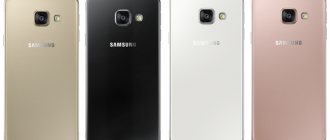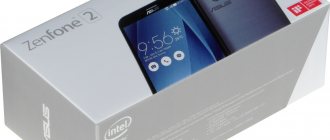ZTE and Huawei are two of the most irreconcilable competitors in the Chinese telecommunications market, and very close in scale - a consumer accustomed to judging by end devices may not even imagine this. In the production of gadgets, Huawei has really made a big leap forward, not only supporting Apple and Samsung in sales, but also counting on more. ZTE is still lagging behind - but does not despair, diligently updating its model range and developing new markets. Including several attempts, like ours, with quite obvious successes - it is in the Russian market that ZTE performs especially well. In this article we will talk about a specific representative of the sub-brand returned to Russia.
ZTE Nubia Z9 Max is an example of the Chinese idea of the right smartphone, and of the 2020 model. Large display (5.5 inches); undisputed design, but the body requires the use of metal; complete stuffing in terms of communications (two SIM cards, LTE, NFC). Unless instead of the MediaTek hardware platform, Qualcomm is used (Snapdragon 615 MSM8939). And all this at a very affordable price: 15,990 rubles. However, there are now many similar proposals coming from China. Maybe Nubia Z9 Max has something to stand out from its peers?
Specifications
| ZTE Nubia Z9 Max | Meizu M3 Note | Honor 5X | Lenovo VIBE P1 | ASUS Zenfone 2 (ZE551ML) | |
| Screen | 5.5 inches, 1920 × 1080 pixels, IPS; capacitive multi-touch | 5.5 inches, IPS, 1920 × 1080 pixels, 401 ppi, capacitive multi-touch | 5.5 inches, IPS, 1920 × 1080 pixels, 401 ppi, capacitive multi-touch | 5.5 inches, IPS, 1920 × 1080 pixels, 401 ppi, capacitive multi-touch | 5.5 inches, IPS, 1920 × 1080 pixels, 401 ppi, capacitive multi-touch |
| Protective glass | No data | Dinorex T2X-1, with oleophobic coating and polarizing filter | No data | Corning Gorilla Glass 3, with oleophobic coating and polarizing filter | Corning Gorilla Glass 3, with oleophobic coating and polarizing filter |
| CPU | Qualcomm Snapdragon 615 MSM8939: four ARM Cortex-A53 cores, 1.11 GHz + four ARM Cortex-A53 cores, 1.46 GHz | MediaTek MT6755 Helio P10: Quad ARM Cortex-A53 1.0 GHz + Quad ARM Cortex-A53 1.8 GHz | Qualcomm Snapdragon 615 MSM8939: four ARM Cortex-A53 cores, 1.11 GHz + four ARM Cortex-A53 cores, 1.46 GHz | Qualcomm Snapdragon 615 MSM8939: four ARM Cortex-A53 cores, 1.11 GHz + four ARM Cortex-A53 cores, 1.46 GHz | Intel Atom Z3580: quad core Tangier architecture (x86-64), 2.33 GHz |
| Graphics controller | Qualcomm Adreno 405, 550 MHz | ARM Mali-T860MP2, frequency 600 MHz | Qualcomm Adreno 405, 550 MHz | Qualcomm Adreno 405, 550 MHz | Imagination Technologies PowerVR Rogue G6430, 533 MHz |
| RAM | 2 GB | 2/3 GB | 2 GB | 2 GB | 4 GB |
| Flash memory | 16 GB | 16/32 GB | 16 GB | 32 GB | 32 GB |
| Connectors | 1 × micro-USB 2.0 | 1 × micro-USB 2.0 | 1 × micro-USB 2.0 | 1 × micro-USB 2.0 | 1 × micro-USB 2.0; |
| 1 × 3.5mm headset jack | 1 × 3.5mm headset jack | 1 × 3.5mm headset jack | 1 × 3.5mm headset jack | 1 × 3.5mm headset jack; | |
| 2 × nano-SIM | 1 × nano-SIM | 1 × micro-SIM | 2 × nano-SIM | 2 × micro-SIM | |
| 1 × microSD | 1 × nano-SIM/microSD (universal) | 1 × micro-SIM/microSD (universal) | 1 × microSD | 1 × microSD | |
| Cellular connection 2G | GSM/GPRS/EDGE 850/900/1800/1900 MHz | GSM/GPRS/EDGE 850/900/1800/1900 MHz | GSM/GPRS/EDGE 850/900/1800/1900 MHz | GSM/GPRS/EDGE 850/900/1800/1900 MHz | GSM/GPRS/EDGE 850/900/1800/1900 MHz |
| Cellular 3G | DC-HSPA 850/900/1900/2100 MHz | DC-HSPA 850/900/1900/2100 MHz | UMTS/HSPA+ 900 /2100 MHz | DC-HSPA 850/900/1900/2100 MHz | DC-HSPA 850/900/1900/2100 MHz |
| Cellular 4G | LTE Cat. 4 (150 Mbit/s, 50 Mbit/s), bands 1, 3, 7, 38, 39, 40, 41 | LTE Cat. 6 (300 Mbit/s, 50 Mbit/s), bands 1, 3, 7, 38, 39, 40, 41 | LTE Cat. 4 (150 Mbit/s, 50 Mbit/s), bands 1, 3, 5, 7, 8, 20, 28 | LTE Cat. 4 (150 Mbit/s, 50 Mbit/s), bands 1, 3, 7, 20, 40 | LTE Cat. 4 (150 Mbit/s, 50 Mbit/s), bands 1, 2, 3, 4, 5, 7, 8, 9, 17, 18, 19, 20, 28, 29, 38, 39, 40, 41 |
| WiFi | 802.11a/b/g/n 2.4/5 GHz | 802.11a/b/g/n 2.4/5 GHz | 802.11b/g/n 2.4 GHz | 802.11a/b/g/n 2.4/5 GHz | 802.11a/b/g/n 2.4/5 GHz |
| Bluetooth | 4 | 4 | 4.1 | 4.1 | 4 |
| NFC | Eat | No | No | Eat | Eat |
| Navigation | GPS, A-GPS, GLONASS | GPS, A-GPS, GLONASS | GPS, A-GPS, GLONASS | GPS, A-GPS, GLONASS, BeiDou | GPS, A-GPS, GLONASS |
| Sensors | Illumination, proximity, accelerometer/gyroscope, magnetometer (digital compass) | Illumination, proximity, accelerometer/gyroscope, magnetometer (digital compass), pedometer | Illumination, proximity, accelerometer/gyroscope, magnetometer (digital compass) | Illumination, proximity, accelerometer/gyroscope, magnetometer (digital compass) | Illumination, proximity, accelerometer/gyroscope, magnetometer (digital compass) |
| Fingerprint's scanner | No | Eat | Eat | Eat | No |
| Main camera | 16 MP autofocus, LED flash | 13 MP, f/2.2, autofocus, dual LED flash | 13 MP, f/2.0, autofocus, dual LED flash | 13 MP, f/2.2, autofocus, optical stabilization system, dual LED flash | 12.6 MP, PixelMaster technology, f/2.0, autofocus, LED flash |
| Front-camera | 8 MP, no autofocus, no flash | 5 MP, no autofocus, no flash | 5 MP, no autofocus, no flash | 5 MP, no autofocus, no flash | 4.9 MP, no autofocus, no flash |
| Nutrition | Non-removable battery: 11 Wh (2900 mAh, 3.8 V) | Non-removable battery: 15.58 Wh (4100 mAh, 3.8 V) | Non-removable battery: 11.7 Wh (3000 mAh, 3.8 V) | Non-removable battery: 19 Wh (5000 mAh, 3.8 V) | Non-removable battery: 11.7 Wh (3000 mAh, 3.8 V) |
| Size | 154.8 × 76.6 × 7.9 mm | 153 × 75 × 8.2 mm | 151.3 × 76.3 × 8.2 mm | 153 × 75 × 9.9 mm | 152 × 77 × 10.9 mm |
| Weight | 165 g | 163 g | 158 g | 189 g | 170 g |
| Water and dust protection | No | No | No | No | No |
| operating system | Android 5.1.1 Lollipop, Nubia UI custom shell | Android 6.0 Marshmallow, Meizu's own Flyme UI shell | Android 5.1.1 Lollipop, Lenovo's own shell | Android 5.1.1 Lollipop, Lenovo's own shell | Android 5.0 Lollipop, ASUS ZenUI shell |
| Current price | 15,990 rubles | 16,990 rubles for the 16 GB version; 18,990 rubles for the 32 GB version | 16,990 rubles | 17,990 rubles | 20,990 rubles |
| ZTE Nubia Z9 Max – information about the filling according to the CPU-Z application, which determines many things incorrectly | ||||
⇡#Appearance, ergonomics and software
ZTE Nubia Z9 Max belongs to the family of “black bricks” that are already leaving the scene, about which colleagues recently wrote funny tests. This representative tries to stand out due to minimalistic splashes of red: on the touch Home key and on the rear panel - in the rim of the main camera, like on the Lenovo Vibe Shot. The unusual texture of the rear panel, made of glossy plastic, and gray metal around the perimeter add individuality - but I would not call this gadget recognizable. It looks good overall, but ZTE smartphones still lack their signature face. To look - and a second later he said: “Yes, this is Nubia.” However, many people have similar problems now, even if the age of black plastic has been replaced by the era of silver metal.
ZTE Z9 Max, official photo
By the way, it is worth mentioning the existence of a white version of the smartphone - but it is not officially supplied to Russia. It's a pity.
ZTE Z9 Max, front panel: above the display there is an earpiece, light sensor and front camera lens, below the display there are three touch keys
For a gadget with a 5.5-inch display, the ZTE Nubia Z9 max turned out to be quite compact: the frames around the screen are not wide, and in terms of thickness (7.9 mm) it is among the leaders. However, you still shouldn’t expect convenient “one-handed” control when buying a smartphone with a large display. It fits in a pocket, or in any bag, too, but it fits in the palm of your hand, and in order to use it somehow, you need to use your other hand. It is also quite natural to complain about the glossy back, which is quite slippery and easily collects fingerprints.
ZTE Z9 Max, rear panel: in the upper left corner - the main camera lens and a single LED flash
All functional elements are in places standard for a modern Android smartphone: on the left edge there are power and volume keys, on the top edge there is a mini-jack for a headset or headphones, on the bottom there is a microUSB connector and a speaker. A set of touch-sensitive system navigation keys is hidden under the display. The central one is highlighted with the aforementioned red circle, the side ones light up pale red only when you click on them. There is no vibration feedback and they are not very convenient to handle. For us, the key block brought back memories of Digma MP3 players from the 2000s - remember those?
ZTE Z9 Max, bottom edge: microUSB connector, conversational microphone, speaker
ZTE Z9 Max, top edge: 3.5 mm audio jack and second microphone
But there are separate slots for both SIM cards and a memory card, so the owner of the Z9 Max is freed from the need to choose between extra memory or additional options when choosing tariffs and numbers. There is no fingerprint scanner or other biometric sensors in the smartphone. The build quality is average - when compressed, the case moves and bends slightly.
ZTE Z9 Max, left side: slots for two nano-SIM cards and a microSD memory card
ZTE Z9 Max, right side: power and volume keys
The operating system here is Android 5.1, but there are plans to update to Android 6.0. On top of Android there is the Nubia UI shell of the current version (currently 3.5.1).
The shell is quite working, fully Russified and adapted for users not from China - although some “tails” still stick out. For example, messages about updates to some Google system applications come in Chinese. In general, you don’t experience any serious discomfort from using Nubia UI – although you need to get used to some things. For example, the “Back” key is located on the right, not the left, and it also brings up a list of open applications when pressed for a long time. The key on the left has only one function - to bring up the desktop settings menu on the screen. Why it was impossible to “hang up” exactly this on a long press of one of the touch keys, and leave the general logic as standard, is unclear.
There are a few other significant differences from stock Android. For example, the ZTE Nubia Z9 Max does not have an application menu - all programs are placed on the endlessly proliferating desktops. The notification curtain and the notification line are branded, and the line is too narrow - the tiny icons are almost invisible. But it is possible to enable one-handed control and split-screen modes, and also provides a number of proprietary control gestures - it is not necessary to enable them.
Nubia UI looks similar to MIUI (Xiaomi) or Emotion UI (Huawei), but in terms of ease of use, speed of operation and quality of Russification it is inferior to the more well-known Chinese shells - despite the fact that ZTE has been present in this market for a long time, making equally high-quality software product, like its competitors, the company has not yet learned. But it’s encouraging to see the minimum number of installed native applications - many Chinese companies tend to impose their software, which then has to be painfully thrown out of the smartphone.
ZTE nubia Z9
21.06.2015Equipment
Black box with Nubia logo. The box is not bulky. Pleasant to the touch.
The device itself is included. There is film on both sides of the phone. Charger without adapter for our sockets. The red USB cable is made using unusual technology (pictured).
Red headphones are packed in a separate dock. It looks very nice. One can feel the desire of the Chinese to please the world market. There are 2 more headphone tips in the dock. In general there are 3 sizes: large, medium, small. So vacuum headphones are suitable for everyone.
Appearance
The device, with its appearance and weight, makes it clear that it is for serious people who value simplicity and elegance at the same time. In front there is a so-called 2.5D display, which gives a frameless effect. The colors are bright and clean. FullHD screen resolution. Diagonal 5.2. Above the display is a proximity sensor, an 8 megapixel camera, and an auditory speaker. There are three touch buttons under the display. The main Home button (circle in the center) also serves as an event indicator, but glows only red. The remaining two dot buttons (back and settings) are illuminated as needed.
There is glass at the back. In the middle there is the inscription Nubia. At the top in the corner is a 16-megapixel camera with a red rim and a flash. At the bottom there is an inscription in Chinese in small print.
The edges of the phone are metal.
On the top edge there is a headphone jack, IR, and an additional microphone.
On the bottom edge there is a microUSB port, a conversational microphone, and a speaker.
We put port number 2 on the side face. On the other side there is a volume rocker, a power and lock button, and a two-position camera button with a red dot in the center.
Design for 10 points.
Interface
The device runs Android 5.0.2. Own Nubia UI shell.
The shell works 100%. No lags or friezes were noticed. There are no random reboots either.
The firmware in the ZTE nubia Z9, ordered from China from the first batches, is damp. But visually it looks great. The translation of the firmware is not complete, there is both English and Chinese! Russian is present at 80%.
I tried to install Google Apps following the example of the Z9 Max, but it didn’t work.
GESTURES are processed with a bang and there are no false positives! Customize as you wish!
One desktop is entirely dedicated to the camera (widget and various effects). And this table is not editable in any way!
Regarding the Qualcomma 810 and the 2900 battery. I was worried about overheating and battery life. But I was pleasantly surprised. The battery holds a charge for one and a half days with average use. But in standby mode it spends about 1% per hour. The processor is powerful. It pulls everything without any problems.
Camera
The camera is great. I myself only shoot in auto mode. Completely satisfied. I'm sure those who like to tweak the settings will get just a masterpiece.
Bottom line
In conclusion, I can only say one thing! Don't be afraid of the Chinese! They have finally entered the quality smartphone market. Many are drawn only to Samsung and Apple and do not want to take the risk of trying something fresh. So look towards the Chinese - discover a new world)))
erkosh359
⇡#Display
The ZTE Nubia Z9 Max has a 5.5-inch LCD with an IPS matrix with a resolution of 1920 × 1080 pixels (density 401 ppi) - no surprises here. The viewing angles are quite normal: even if the contrast is lost even with a slight deviation from the perpendicular, it’s quite possible for two people to watch something on a smartphone. The touchscreen is responsive, it recognizes all the necessary gestures, but there are erroneous responses or too slow response to touches - however, I attribute this to the peculiarities of the Nubia UI shell. A polarizing filter, an oleophobic coating (not the most effective, but it's what it is), the absence of an air gap between the glass and the matrix - the whole set is in place. But there’s nothing to say about protective glass - we can’t live without it now, but there is no official information about whose solution is being used.
The display is quite bright – 452 cd/m2. This is enough to safely use your smartphone in the bright sun: catching Pokemon with the Z9 Max is quite doable and enjoyable. The minimum color luminosity in the same mode is 38 cd/m2. At maximum brightness in the dark there is no need to look at the smartphone screen again; it is better to use automatic adjustment - there is a light sensor, everything works quite correctly.
The static contrast level is low – 906:1. This is quite an ordinary indicator for the LCD display of a mid-level smartphone; many are now even higher. The minimum black field luminosity recorded by our sensor is 0.51 cd/m2. ZTE Nubia Z9 Max cannot boast of deep realistic blacks.
What is more regrettable is that it cannot boast of normal color rendition. Several profiles are offered, both in saturation and hue. The default is “moderate” saturation and “normal” hue. Even in normal conditions, the color temperature jumps in the range from 8000 to 10000 K in shades of gray without a hint of stability, and what will happen in cool conditions is scary to imagine.
ZTE Nubia Z9 Max, color temperature. Blue line – Z9 Max performance, dotted line – reference temperature
ZTE Nubia Z9 Max, gamma. Yellow line – Z9 Max performance, dotted line – reference range
It is logical that the blue graph deviates sharply from the norm, although the green and red gammas, in principle, look good. In general, according to the Color Checker test, which includes a wide color spectrum and shades of gray, the average deviation DeltaE is large - 6.24. It is due to gray and blue-blue. As for the average gamma, everything is relatively decent here - 2.16, while the standard, let us remember, is 2.2.
ZTE Nubia Z9 Max, color gamut. Gray triangle – sRGB coverage, white triangle – Z9 Max coverage
Overall, the display is somewhat disappointing - despite a good combination of resolution and diagonal, it is poorly configured and cannot boast of high contrast.
⇡#Hardware and performance
There are a lot of ZTE Nubia Z9 Max options on the Chinese market: some use the Snapdragon 810 platform, some use the Snapdragon 615, and they can have 2 or 3 GB of RAM. But the simplest version is officially supplied to the Russian market - with Qualcomm Snapdragon 615 and 2 GB.
The Qualcomm Snapdragon 615 hardware platform is very familiar to us - last year we tested many smartphones with it on board, for example the Honor 5X, which can be considered the most direct competitor of the Z9 Max. The same, simpler version of the system-on-chip is used, with eight ARM Cortex-A53 cores, four of which operate at 1.11 GHz and the other four at 1.46 GHz. Graphics subsystem – Adreno 405 with a clock frequency of 550 MHz.
Both the strengths and weaknesses of the Z9 Max correspond to what we saw from the Honor 5X: similar results in benchmarks, calm and smooth work with basic applications and games that do not require a serious load on the graphics subsystem, stability. In the WEBXprt browser performance test, ZTE Nubia Z9 Max even outperforms its competitor from Huawei - 54 points versus 51.
And the nice bonus is the same: the ability to use a memory expansion card without sacrificing one of the SIM cards - the slots are separate. In principle, the layout of modern smartphones is a very unified matter; it’s not easy to come up with something out of the ordinary. It’s easier to fail by trying too hard. But ZTE is not failing.
The Z9 max has 16 GB of internal memory, of which about 11 GB is available to the user. During testing, the smartphone never froze critically and, despite the hot weather, did not overheat until turned off or rebooted. A modern device that is quite normal in its performance.
Review of the ZTE Nubia Z9 Max Android smartphone: a top model or a marketing trick?
Table of contents
- Introduction
- Specifications
- Packaging and equipment
- Appearance and design
- Display
- Hardware platform and performance
- Software and firmware
- Multimedia
- Wireless Interfaces and Communications
- File system
- Battery life
- Camera
- Comparison with competitors
- Conclusion
Introduction
ZTE often attracts our attention as a manufacturer with a good reputation, which offers the market interesting mobile solutions, but at a more attractive price than its competitors, and with its own features.
Relatively recently, the usual ZTE Z9 from the Nubia line visited the laboratory, leaving the impression of a worthy, reliable and beautiful smartphone. Following this, we reviewed the ZTE Z11 mini, which offers good performance in a compact body.
Thanks to our partner, the Cheap-mobile online store, we got our hands on the ZTE Z9 Max. According to the manufacturer, in the larger version we will get a fast, beautiful and high-quality smartphone, but at a more reasonable price.
We will check to what extent this statement corresponds to reality in this article, and we will begin traditionally with technical characteristics and listing some features.
announcements and advertising
2080 Super Gigabyte Gaming OC for 60 rubles.
Compeo.ru - the right comp store without any tricks
RTX 2060 becomes cheaper before the arrival of 3xxx
Ryzen 4000
series included in computers already in Citylink
The price of MSI RTX 2070 has collapsed after the announcement of RTX 3xxx
Core i9 10 series is half the price of the same 9 series
The price of memory has been halved in Regard - it’s more expensive everywhere
Specifications ZTE Nubia Z9 Max
| Device type | Smartphone |
| Model | ZTE Nubia Z9 Max |
| Housing materials | Glass + metal + plastic |
| Screen | 5.5″, Full HD, IPS |
| CPU | Qualcomm Snapdragon 615 / Qualcomm Snapdragon 810 |
| Video processor | Adreno 405 / Adreno 430 |
| operating system | Android 5.0.2 + Nubia UI 3.0.8 |
| RAM, GB | 2/3 |
| Built-in storage, GB | 16/64 |
| Memory card slot | Eat |
| Cameras, Mpix | 16.0 + 8.0 |
| Battery, mAh | 2 900 |
| Dimensions, mm | 154.8 x 76.7 x 7.9 |
| Weight, g | 165 |
| price, rub. | 14 000 – 18 000 |
We have before us an interesting mid-level solution, built on the Qualcomm Snapdragon 615 platform and part of the Nubia line. We are promised good mobile shooting, fast operation, and only the battery capacity of a relatively large diagonal raises some questions.
Additionally, we note that several modifications of the device are available. These are three versions with the Qualcomm Snapdragon 615 platform, 2 GB of RAM and 16 GB of storage, which differ only in firmware and frequencies. We have just such a smartphone on test with the firmware adequately translated into Russian. And two more versions with Qualcomm Snapdragon 810 on board, 3 GB of RAM and 64 GB of internal memory. This model features a built-in AK4375 audio chip, and one of them is equipped with a fingerprint scanner and a USB Type-C connector.
Packaging and accessories ZTE Nubia Z9 Max
ZTE Z9 Max comes in a large, beautiful black cardboard box. The chosen material is pleasant to the touch and well processed. On the front side, the user is presented only with the name of the line; the packaging design is minimalist; one can also note the presence of red accents – the ZTE corporate color.
In this format, the packaging fully copes with its tasks of protecting the device during transportation; the cardboard used is thick.
On the reverse side, a special sticker at the bottom indicates the modification of the device, a small summary of technical characteristics and legal data, such as the serial number.
After opening the box, you can see the smartphone itself in a special recess in the protective matte transport film. There is a small “strap” for comfortable and quick removal of both the device and the backing.
Let's look at the delivery set, which is located just below the cardboard backing:
- Compact charger;
- USB Micro-USB cable;
- Documentation, which is located in the backing in a special pocket.
All complete elements are securely fastened in their “pockets”. The kit, as is the case with most modern smartphones, is modest; the manufacturer even abandoned the headset. Here is a minimum set for starting everyday use.
The ZTE company only diluted the picture with a branded sticker. There are no complaints about the quality of the accessories. The charger is compact and easy to use. Fast charging technology does not appear to be supported.
It is worth paying attention to the shape of the included Micro-USB cable; it does not get tangled and most likely will not get lost on the table due to its bright colors. In addition, it is equipped with a special convenient strap for securing and subsequent transportation.
⇡#Communications and wireless communications
ZTE Z9 Max, SIM card slots and memory cards
ZTE Nubia Z9 Max works with two nano-SIMs according to the standard dual stand-by scheme - there is one radio module, so when a call is received on one card, the second one is temporarily turned off. You can also assign one card for calls and the other for the Internet; but only one slot can work with fourth generation networks. By the way, LTE category 4 is supported (theoretical data transfer speed is up to 150 Mbit/s). Unfortunately, not all ranges are available, even those that are critical for Russia. Available are 1, 3, 7, 38, 39, 40, 41. The 20th is missing, with which, in particular, Beeline works. However, I walked with a smartphone with a Beeline SIM card installed in it for a little over a week and did not feel any noticeable gaps in the coverage that was familiar to me.
But Wi-Fi has all the necessary frequencies, unlike Honor 5X: 802.11a/b/g/n/ac standards and frequencies of 2.4 and 5 GHz are supported. The smartphone is also equipped with Bluetooth 4.0 and NFC. The presence of the latter for the average Chinese smartphone is almost a roulette, a lottery: it may or may not happen. There is a Near Field Communication module here.
| ZTE Nubia Z9 Max, AndroiTS GPS Test results | ||
Navigation works with GPS (A-GPS) and GLONASS. It functions normally, without any special features. The smartphone finds from 14 to 18 satellites per minute, its accuracy is sufficient for auto navigation.
⇡#Camera
ZTE Z9 Max, main camera
All smartphone manufacturers are feverishly competing today in shooting quality. Huawei signs contracts with Leica, Apple and completely bases the entire iPhone advertising campaign on the laconic publication of pictures taken with the camera of its devices. ZTE also tried its best - although the company does not yet have such skill in throwing dust in the eyes, it has equipped its mid-level device with two cameras with quite reasonable characteristics: a front one with 8 megapixels and a main one with 16 megapixels.
The main feature of ZTE is a special screen with a set of different bells and whistles for shooting, both photos and videos: there is, for example, slow-motion video shooting, multiple exposures with the ability to overlay translucent frames, various special effects, the ability to control the aperture, and so on. In principle, for mobile shooting, most of the proposed functions are simply not needed, especially since the interface has annoying errors in the Russian language like “electronic aperture” - but complaining about the redundancy of capabilities in this case would be somehow stupid.
The interface, if you subtract the mentioned problems, is quite good, with logical controls and nice additions like a virtual horizon, compass and built-in grid. HDR must be turned on forcibly; there is a manual mode that allows you to set focus, sensitivity, white balance, shutter speed and exposure compensation.
In terms of shooting quality, the ZTE Nubia Z9 Max does not demonstrate anything unexpected for a Chinese smartphone for 16 thousand - neither for the bad nor for the good. Pros: color rendition quite close to natural, normal work with white balance. Cons: weak macro photography, uncertain work with backlight, too inaccurate autofocus in poor lighting and weak microsharpness - when zoomed in at 100%, chromatic noise is visible better than image details. It is not possible to shoot something digestible on the Z9 Max in the dark - the picture crumbles into color noise, completely losing detail.
ZTE Nubia Z9 Max-cameragallery
View all images (25)ZTE Nubia Z9 Max records video only with Full HD resolution – only the Chinese version with Snapdragon 810 on board can shoot in 4K.
The front camera is quite functional - yes, there is no autofocus or flash, but 8 megapixels for selfies is already good. In normal lighting, artificial or natural, self-portraits turn out pleasant. In the dark, the front camera becomes, alas, useless.
Nubia Z9 Max review
We welcome everyone to our cozy website!
Let's talk today about another large metal smartphone. We have the ZTE Nubia Z9 Max (NX512J) model for review today. Let’s say right away that there is a model with the Elite prefix, it is much more powerful and has more memory. But we are not talking about him, but about the younger Nubia Z9 Max.
Specifications:
- Housing materials Metal frame, plastic
- Operating system Android 5.1
- Screen 5.5″ IPS, 1920 x 1080, 401 PPI
- Cameras 16 MP + 8 MP
- CPU (processor) Qualcomm Snapdragon 615, 8 cores up to 1.5 GHz
- Video processor Adreno 405
- RAM (random access memory) 2 GB
- ROM (built-in memory) 16 GB (free 10.8) + MicroSD up to 128 GB
- GSM/3G/4G communication
- SIM cards 2 nano SIM + MicroSD slot
- FM radio Yes
- Data transfer Wi-Fi, Bluetooth
- GPS/GLONASS/BDS Yes / No / No
- Battery, mAh 2900
- Real battery test 6 hours, 18 minutes video at maximum brightness
- Dimensions, weight 76.6 x 154.8 x 7.9 mm, 165 grams
- Features: Notification sensor in the home button, adjusting the color temperature of the screen, locking the screen with your palm, unlocking with a double tap, splitting the screen into two, the ability to swap the back and menu touch buttons, a huge number of settings and camera features.
The design of the Nubia Z9 Max can be called beautiful. The edging is made of metal, and the back is black plastic. By the way, the plastic is quite easily soiled, so you will have to wipe it often.
The kit is simple. In our case, this is a charger and a red (!) microUSB cable, so that you do not confuse your microUSB from ZTE with other microUSBs.
There are two slots on the left side. One is designed for two nanoSim cards, and the second, separate, for a microSD memory card.
On the right we see only the power button with a volume rocker.
At the bottom there is an original speaker and a microUSB connector. Seriously, I haven't seen such an arrangement for a very long time. This is where the designers stood out.
At the top there is an additional microphone and a headphone jack. Again, we won’t praise the sound, but there’s nothing to criticize either. It is not for aesthetes, but for ordinary lovers of listening to music in transport. You will be pleased, seriously, but you shouldn’t expect stunning studio quality, although the sound still reaches “plus”.
There is no fingerprint scanner here, which is good, I think.
The screen of the Z9 Max is standard, good quality, if you remember what displays modern inexpensive smartphones can boast of. 5.5-inch IPS matrix with fullHD resolution.
I must say that this is the optimal solution, therefore it is used everywhere and this is normal.
A good emphasis was placed on cameras. There are two of them here (16 MP + 8 MP), I think there is no need to explain which is the front and which is the rear). Let us note the simply incredible number of shooting modes and settings.
However, this quantity did not in any way affect the quality of pictures and videos. They turn out average. Judge for yourself:
And video:
The emphasis has been made, but not completely.
But how the guys from ZTE worked out the functionality and appearance of the shell of their device. The main menu does not have an application menu. The curtain is made in an elegant style and has its own charm, you will agree.
Gesture control is well developed, see for yourself, there is a minimum set of unusual gestures.
Control buttons are configured in the menu. This, of course, is not as well implemented as in LG, for example, but it will also be very useful.
Calling screen also looks very lively and specific. Note the function of recording telephone conversations, which is quite rare.
Well, the same can be said about the music player interface. By the way, ZTE engineers also allowed us to customize the sound for ourselves.
Here's another list of settings that your phone has.
The Qualcomm Snapdragon 615 processor gets a little warm under load, you can feel it, so we don’t recommend loading your smartphone a lot or often. Fortunately, he won’t allow you to do this, because not all powerful modern games can handle it. And there is not much built-in memory, only 16 GB, of which approximately 10 GB is available. But a memory card is provided, so there should be no problems with the content.
Networks can tell you a lot of interesting things. Here, in addition to standard Bluetooth and Wi-Fi, which are everywhere, there is also an FM radio, which many people have been abandoning lately, and an NFC module, which few people install in smartphones at all. GPS reception turned out to be average, judging by the tests:
The autonomy of the smartphone is again average. Well, what else can you expect from a device with an 8-core processor and a large screen, equipped with a 2900 mAh battery. The device will withstand daylight hours, like most modern devices.
The smartphone turned out to be ambiguous, but beautiful. Both externally and internally, plus many features that are captivating, but if you close your eyes to them and judge by the facts, then the device is very average and it has a great many competitors.
Pros:
- Design,
- Good build quality,
- Sound in headphones
- Screen,
- 2 SIM + memory card in a non-separable case - a rare sight!
Minuses:
- Performance is weak for its price (nitpicking), moderate, but gets hot under load.
Arstyle rating 8 points out of 10!
Author of the text: Volobuev Alexander. Your comments and thoughts about this device are welcome in the comments. Well, don’t forget to watch a short video review:
⇡#Autonomous work
When a smartphone with a 5.5-inch display is equipped with a battery of less than 3000 mAh, this always causes some skepticism. The Z9 Max uses an 11 Wh battery (2900 mAh, 3.8 V) - yes, the critical mark has been passed. But in fact, no disaster occurs - the smartphone confidently lives through the working day, even with active use and an hour and a half of playing Pokemon Go. It won’t last a day in this mode, but 12-13 hours of daylight is enough.
There are no specific energy saving modes here - only the standard one built into Android 5. The smartphone is fully charged via the adapter in about three hours - no records here either. A regular microUSB port is used, the advantages of which (wires are everywhere) outweigh the disadvantages (slower, asymmetrical).
In our usual test, which involves playing HD video at maximum brightness, with wireless modules turned on and updates active, the ZTE Nubia Z9 Max lasted six and a quarter hours - not at all impressive.

